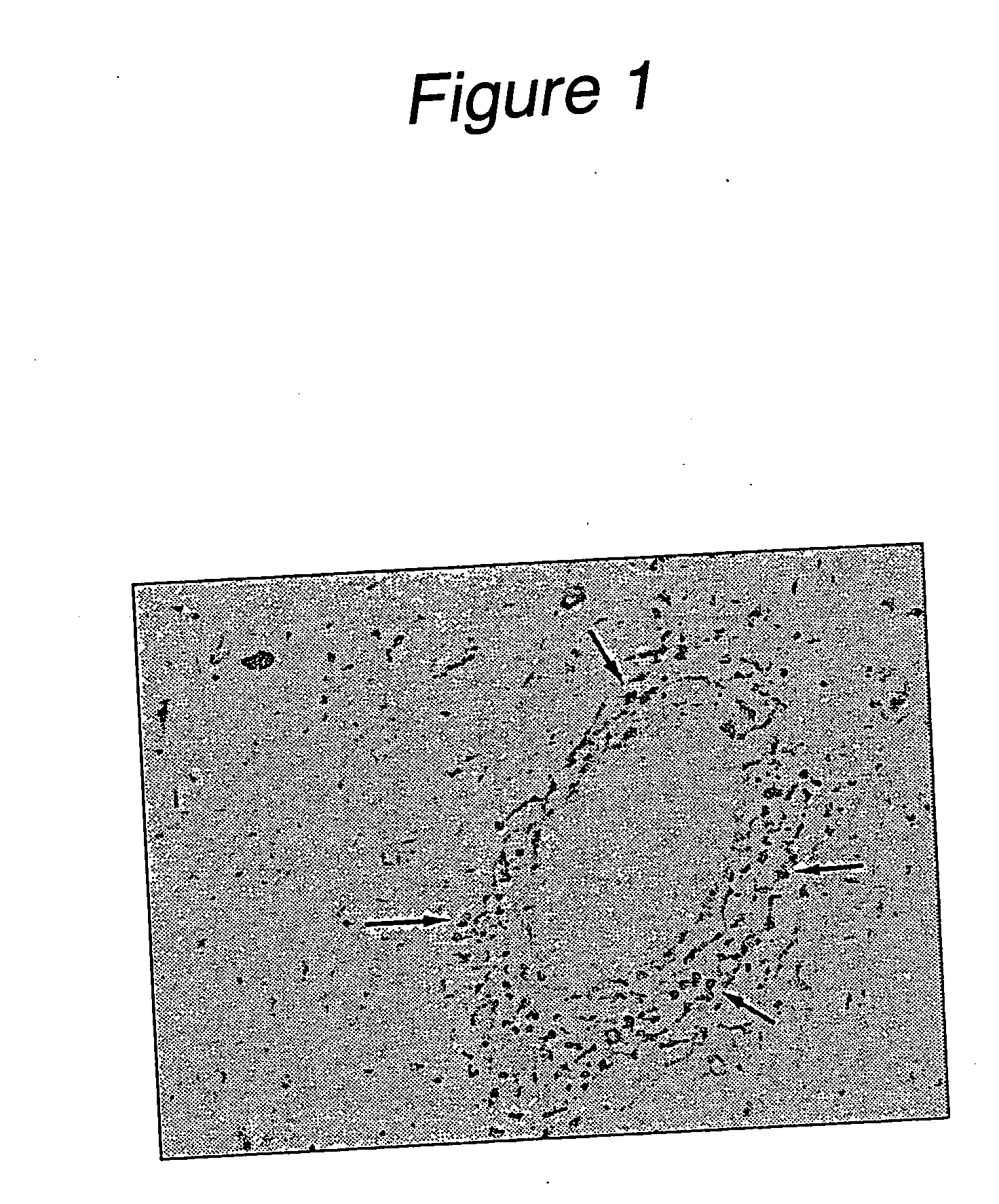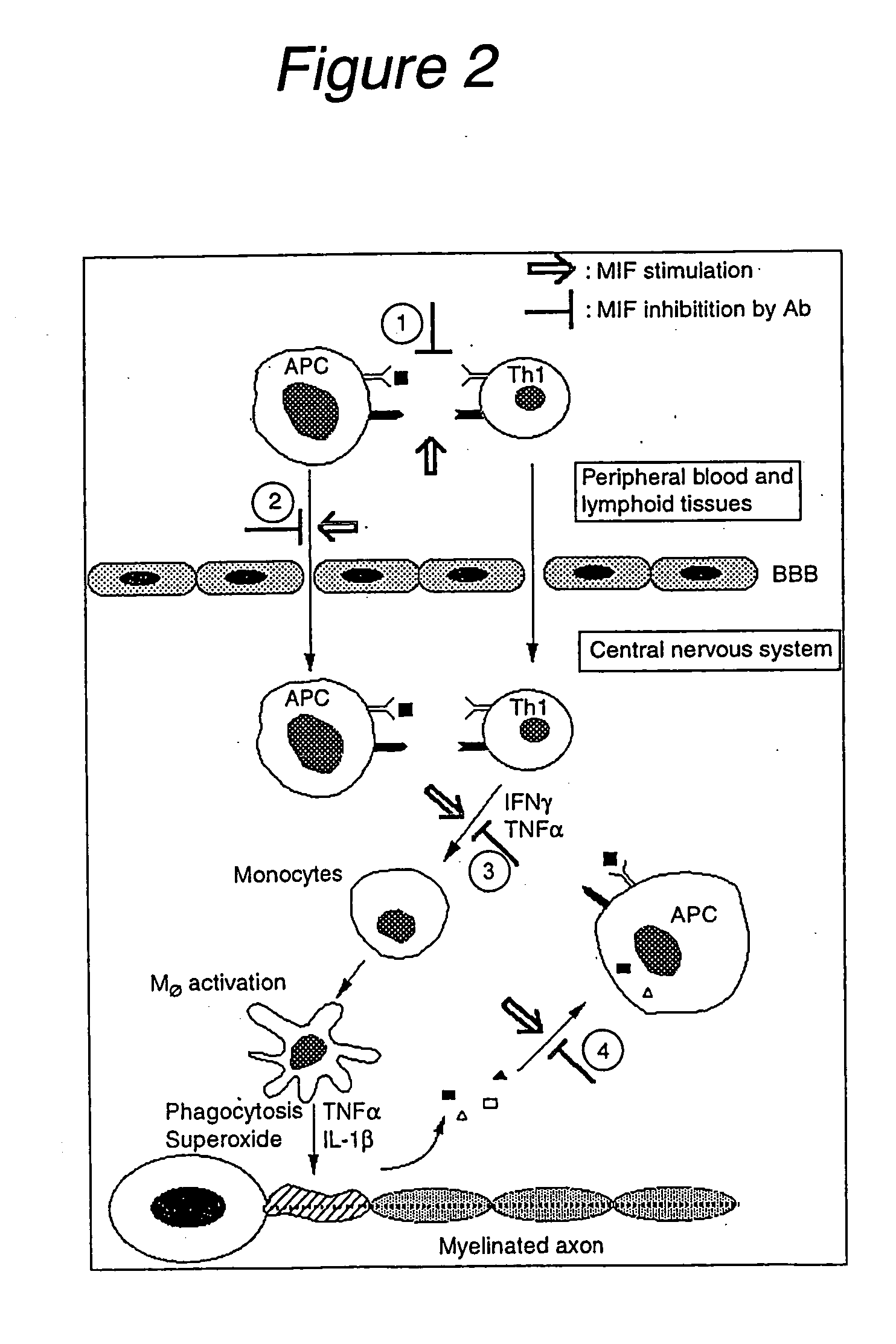Therapeutic agents for multiple sclerosis
a technology for multiple sclerosis and therapeutic agents, applied in the field of multiple sclerosis therapeutic agents, can solve the problems of unsatisfactory and effective therapeutic methods, and achieve the effect of improving the quality of li
- Summary
- Abstract
- Description
- Claims
- Application Information
AI Technical Summary
Benefits of technology
Problems solved by technology
Method used
Image
Examples
example 1
MIF Expression in the CNS of MS Patients
[0091] The typical pathological features of MS are perivascular inflammatory cell infiltration and myelin loss, mostly around the periventricular white matter, in the optic nerve tract, brainstem and corpus callosum. During demyelination, resident microglial cells and astrocytes become activated, followed by the development of astrogliosis. An autopsy specimen from a medulla lesion of a 21-year-old woman with MS was observed. It showed demyelination and perivascular leukocyte infiltration demonstrating typical active MS plaques. In situ hybridization revealed that MIF mRNA was expressed in perivascular leukocytes, astrocytes and microglia in the white matter lesion (FIG. 1). High MIF mRNA expression in MS lesions suggests that MIF might be directly related to the disease progression.
example 2
MIF Levels in the CNS of MS Patients
[0092] To better understand the pathological role of MIF in MS, MIF levels in the cerebrospinal fluid (CSF) of patients with two different types of MS, the conventional form of multiple sclerosis (C-MS) and the optic-spinal form of the condition (OpS-MS), were examined.
[0093] The results are shown in Table 1 below.
TABLE 1MIF levels in CSFMIF (ng / ml)Control2.38 ± 0.18C-MS in relapse4.13 ± 0.30 in remission2.65 ± 0.19OpS-MS in relapse5.53 ± 0.66
Note:
Values are expressed in mean ± SD (n = 5).
[0094] High levels of MIF in the CSF of patients with the immune-mediated diseases were observed. Patients with either C-MS or OpS-MS in acute relapse had significantly higher MIF levels in the CSF than control subjects. Moreover, MIF levels in CSF of OpS-MS patients in relapse were higher than those in C-MS patients in relapse. The mean MIF level in the CSF of C-MS patients in relapse was significantly higher than in the remitting phase. On the other ha...
example 3
Effects of Anti-MIF Antibodies on an EAE Mouse Model
[0095] Investigation of the T-cell receptor and encephalitogenic epitopes involved in EAE has led to a number of experimental therapeutic strategies that have potential relevance to the treatment of MS. It is known that chronic relapsing EAE is an autoimmune disorder characterized by inflammation and demyelination in the CNS. In brief, the adoptive transfer of myelin basic protein (MBP)-specific CD4+ class II MHC-restricted T-cells into naive syngeneic mice produces pathological states resembling MS in humans (Pettinelli CB et al., J Immunol (1981) 127:1420-1423). Accordingly, a model of EAE was used to evaluate the role of MIF in the regulation of autoimmune diseases.
[0096]
[0097] EAE was induced in C57 mice by the known method described above (Pettinelli CB et al., J Immunol (1981) 127:1420-1423). The mice in which EAE was induced were treated with 200 μg of an anti-MIF antibody (a polyclonal antibody prepared in-house by immuni...
PUM
| Property | Measurement | Unit |
|---|---|---|
| Therapeutic | aaaaa | aaaaa |
| Inhibition | aaaaa | aaaaa |
Abstract
Description
Claims
Application Information
 Login to View More
Login to View More - R&D
- Intellectual Property
- Life Sciences
- Materials
- Tech Scout
- Unparalleled Data Quality
- Higher Quality Content
- 60% Fewer Hallucinations
Browse by: Latest US Patents, China's latest patents, Technical Efficacy Thesaurus, Application Domain, Technology Topic, Popular Technical Reports.
© 2025 PatSnap. All rights reserved.Legal|Privacy policy|Modern Slavery Act Transparency Statement|Sitemap|About US| Contact US: help@patsnap.com



